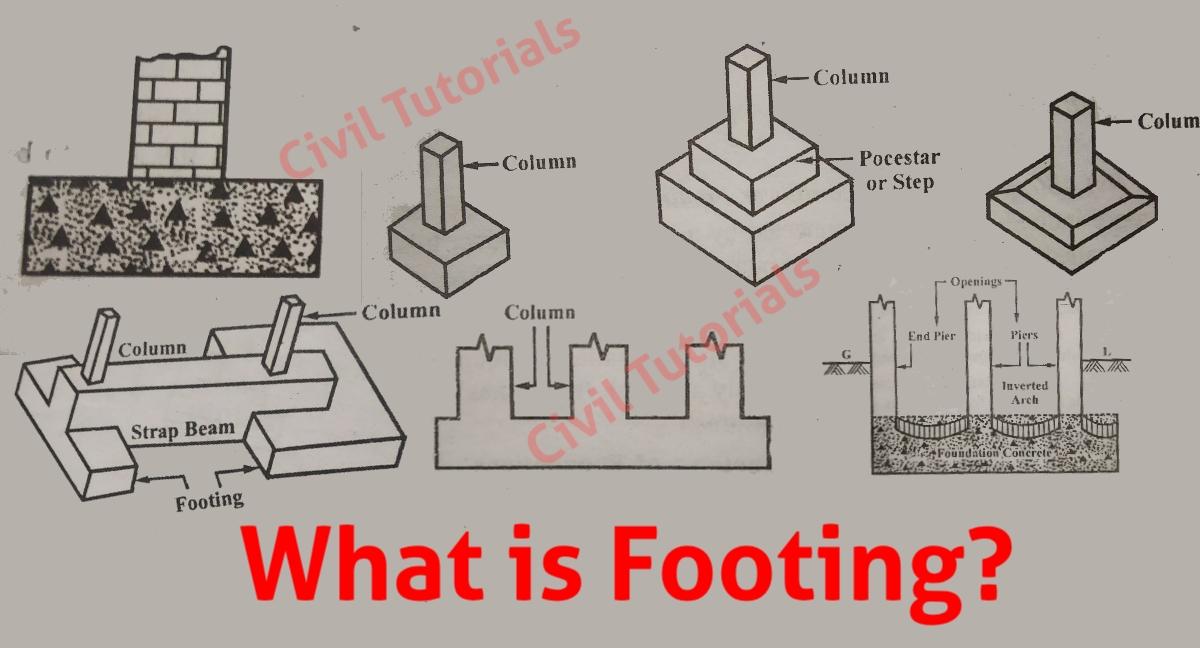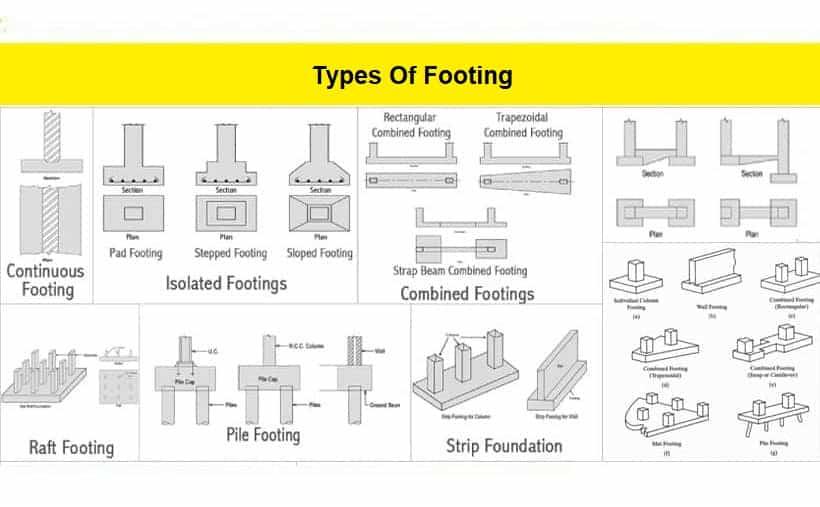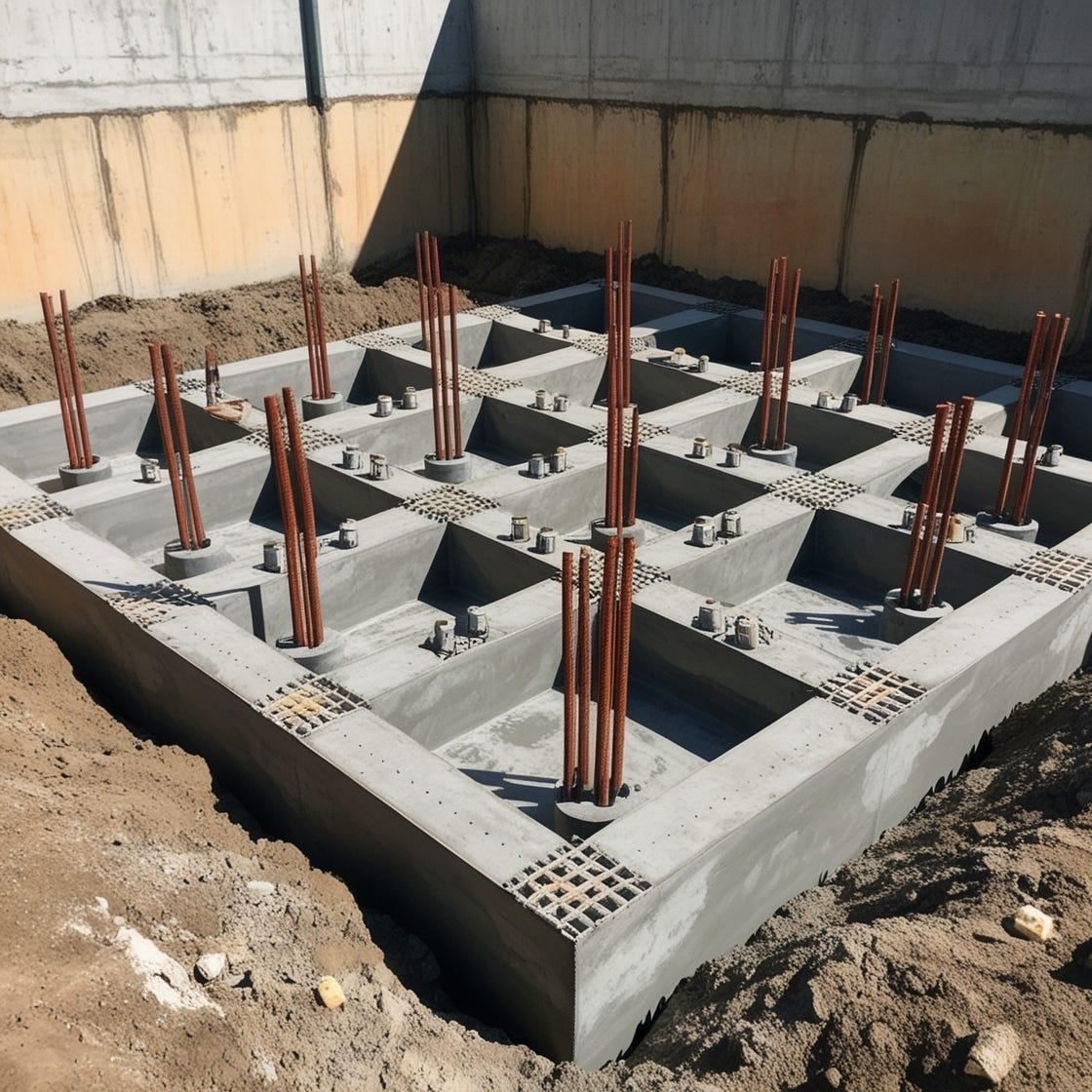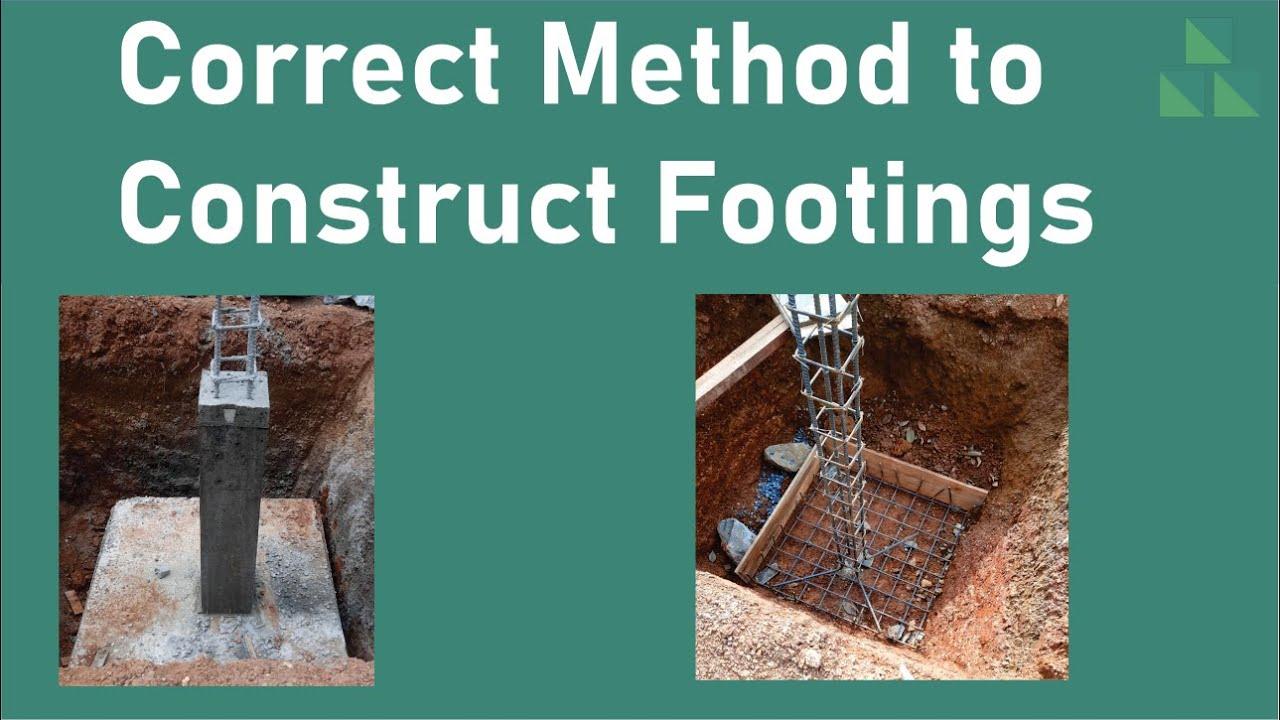



Table of Contents
- Introduction to Footings
- Factors Influencing Footing Selection
- Types of Footings
- Design Considerations for Footings
- Best Practices in Footing Construction
- Conclusion
- Faq's
In the realm of construction, the foundation serves as the bedrock upon which the stability and longevity of a structure rest. A critical component of this foundation is the footing, designed to effectively distribute the load of the building to the underlying soil. Selecting the appropriate type of footing is paramount, as it ensures structural integrity, prevents undue settlement, and accommodates varying soil conditions. This comprehensive guide delves into the various types of footings utilized in construction, with a particular focus on their application within the Indian context.
Introduction to Footings
 What is Footing, Civil Tutorials
What is Footing, Civil Tutorials
Footings are the structural elements that transfer the load from the building to the ground, ensuring that the structure remains stable and upright. They are typically constructed from concrete and are designed to spread the weight of the building over a larger area, preventing excessive settlement or movement. In India, where soil conditions can vary significantly, the choice of footing is crucial to accommodate these variations and ensure the durability of the structure.
Factors Influencing Footing Selection
Several factors must be considered when selecting the appropriate footing for a construction project:
Soil Bearing Capacity
Soil bearing capacity is a crucial factor in footing selection as it determines the ability of the ground to support the structure's weight without excessive settlement or failure. If the soil has a high bearing capacity, simpler and shallower footings like isolated or strip footings can be used. However, for weaker soils, deeper foundations like raft or pile footings may be required to transfer loads to more stable strata. Soil testing and geotechnical analysis are essential before determining the appropriate footing type, ensuring long-term stability and preventing structural failures.
Load Characteristics
The type and magnitude of loads acting on a building significantly impact the choice of footing. These loads can be vertical (due to the weight of the structure), horizontal (due to wind or seismic forces), or dynamic (from machinery or vehicular movement). A structure with heavy or dynamic loads may require deeper and reinforced footings, such as pile or raft foundations, to distribute stress evenly. In contrast, low-rise buildings with lighter loads can be supported using shallow footings, such as isolated or strip footings.
Water Table Level
The groundwater level plays a vital role in footing design, as high water tables can weaken soil strength and cause instability. In areas with high groundwater, water-resistant materials, proper drainage systems, and waterproofing techniques are essential to prevent water infiltration and erosion. Deeper foundations, such as pile footings, are often preferred in such conditions to reach stable soil layers and prevent issues like foundation settlement, water seepage, and concrete deterioration over time.
Environmental Conditions
External environmental factors such as seismic activity, soil erosion, and frost heave can impact the selection of an appropriate footing. In earthquake-prone regions, footings need to be designed to absorb and distribute seismic forces effectively, often requiring reinforced or deeper foundations like raft or pile footings. Similarly, in areas prone to soil erosion or frost action, additional reinforcement and anchoring techniques are necessary to ensure long-term structural stability.
Structural Design and Layout
The positioning and configuration of structural elements, such as columns and walls, influence footing selection. If the columns are spaced widely apart, isolated footings are often sufficient. However, when multiple columns are close together, combined or strap footings may be required to prevent overlapping. For larger buildings with irregular layouts, raft foundations help distribute loads uniformly. The overall architectural design must be considered to ensure that the foundation system aligns with the structure's load path, maintaining stability and efficiency.
Also Read: Efflorescence in Construction: Causes, Prevention, and Removal Methods
Types of Footings
a. Isolated Footing
Also known as pad or individual footing, isolated footings support single columns and are typically square, rectangular, or circular in shape. They are used when columns are spaced at relatively long distances. This type of footing is economical when the soil bearing capacity is high and the loads from the structure are relatively low. In India, isolated footings are commonly used in residential buildings where the loads are not excessive.
b. Combined Footing
Combined footings support two or more columns when they are close enough that their individual footings would overlap. They are often rectangular or trapezoidal in plan. This type of footing is used when columns are spaced closely, and the soil bearing capacity is low, requiring a larger area to distribute the load. In urban Indian settings, where space constraints are common, combined footings are frequently employed.
c. Strip Footing
Also known as continuous footing, strip footings support a line of columns or a load-bearing wall. They are used when loads are transmitted through walls rather than columns. This type of footing is suitable for light structures with load-bearing walls and is common in residential construction in India.
 Types of Footing, Daily Civil
Types of Footing, Daily Civil
d. Mat or Raft Footing
Mat or raft footings consist of a large concrete slab covering the entire footprint of the structure, supporting multiple columns and walls. They are used when soil bearing capacity is low, and individual footings would require more than half of the building area. This type of footing distributes the load evenly and reduces differential settlement. In India, mat foundations are often used in commercial buildings and high-rise structures.
e. Strap Footing
Strap footings involve connecting two or more footings with a concrete beam, known as a strap, which does not bear any load but helps maintain the alignment of the footings. They are used when columns are so close that their footings would overlap, or when a column is near a property line, and an eccentric footing is required. In densely populated Indian cities, strap footings are used to optimize space.
f. Pile Footing
Pile footings use long, slender columns made from materials like concrete, steel, or timber, driven deep into the ground to transfer loads to a more stable soil layer or bedrock. They are used when the upper soil layers are weak or compressible. In India, pile foundations are common in coastal areas and regions with soft clay or expansive soils.
g. Slab-on-Grade Foundation
Slab-on-grade foundations consist of a concrete slab poured directly at ground level, serving as both the foundation and the floor of the building. They are used in areas with stable soil and minimal frost action. In India, this type of foundation is common in regions with warm climates and stable soil conditions.
Also Read: Types of Stirrups in Concrete Structures: How They Prevent Shear Failure
Design Considerations for Footings
When designing footings, several key considerations must be addressed:
Load Distribution
One of the most important design considerations for footings is ensuring proper load distribution to the underlying soil. The footing must be designed to evenly spread the building's weight over a sufficiently large area to prevent excessive settlement or soil failure. Uneven load distribution can lead to differential settlement, which may cause cracks in walls, floors, and other structural elements. Engineers must calculate the load-bearing capacity of the soil and determine the right type and size of footing to balance structural forces effectively.
Soil-Structure Interaction
Understanding soil-structure interaction is essential to predict how the ground will behave under the applied loads and how the building will respond to soil movement. Certain soils, such as clay, expand and contract with moisture changes, which can cause foundation shifting. In such cases, deep foundations like pile footings may be required. Proper geotechnical analysis helps in choosing the right footing type, ensuring that the foundation remains stable and does not experience issues like tilting or differential settlement.
 Design Considerations for Footings, Medium
Design Considerations for Footings, Medium
Depth of Footing
The depth of the footing is a crucial factor in ensuring structural stability. A shallow footing may not provide adequate support, especially in areas with weak soil or high moisture content. Footings must be placed below the zone of seasonal moisture variation to prevent damage due to soil expansion and contraction. In colder regions, they should be deep enough to prevent frost heave. Additionally, in areas with poor topsoil, deeper foundations such as pile or raft footings may be necessary to reach a stable stratum.
Material Selection
The quality of materials used in footing construction directly impacts its strength and durability. High-grade concrete and reinforcement steel must be used to ensure the footing can withstand compressive and tensile forces. The concrete mix must be designed to achieve the required strength, and proper curing must be done to enhance durability. Additionally, corrosion-resistant reinforcement is preferred in coastal or high-moisture areas to prevent long-term deterioration of the foundation.
Waterproofing & Drainage
Proper waterproofing and drainage systems are essential to prevent water accumulation around the footing, which can weaken the foundation over time. If water seeps into the footing, it can lead to erosion, reduced soil bearing capacity, and structural instability. Drainage solutions such as gravel beds, perforated pipes, and sump pits help in diverting excess water away from the foundation. Waterproof coatings or membranes may also be applied to protect concrete footings from water damage.
Seismic Considerations
In earthquake-prone regions, footings must be designed to absorb and dissipate seismic forces to prevent structural failure. Special foundation techniques, such as base isolators or reinforced concrete footings with additional tie beams, can help improve stability during earthquakes. Deep foundations like pile or raft footings are often used in seismic zones to reduce the risk of settlement or liquefaction. Adhering to seismic design codes and ensuring proper reinforcement can significantly enhance the earthquake resistance of a structure.
Also Read: House Framing and Structural Integrity: What Every Homeowner Should Know
Best Practices in Footing Construction
To ensure the durability and stability of footings, the following best practices should be followed:
Soil Testing
Conducting thorough soil testing is a fundamental step in footing construction, as it determines the soil's bearing capacity, composition, and suitability for supporting a structure. Geotechnical investigations, including standard penetration tests (SPT) and plate load tests, help engineers decide the appropriate footing type. Weak or expansive soils may require deep foundations like pile footings, while stable soils can support shallow foundations like isolated or strip footings. Proper soil testing prevents structural failures and ensures long-term stability.
Proper Excavation
Excavation must be carried out with precision to achieve the required depth and dimensions for the footing. Over-excavation or disturbance of adjacent soil can compromise stability, leading to settlement issues. The excavated area should be kept dry and free from loose soil or debris before placing the footing. In cases where excavation is deep, side protection measures such as shoring or retaining walls should be used to prevent soil collapse. Proper excavation lays the groundwork for a stable and durable foundation.
 Best Practices in Footing Construction, YT
Best Practices in Footing Construction, YT
Quality Materials
The strength and longevity of footings depend on the quality of materials used in construction. High-grade cement, reinforcement steel, and well-graded aggregates must be used to achieve the desired strength and durability. The concrete mix should be designed according to the structural requirements, and additives like waterproofing agents may be incorporated for enhanced performance. Poor-quality materials can lead to foundation cracks, reduced load-bearing capacity, and premature structural failure.
Adequate Curing
Curing is essential to ensure that the concrete gains its full strength and durability over time. After the concrete is poured, it must be kept moist for a specific period (typically 7 to 14 days) to prevent rapid drying, which can lead to cracks and reduced strength. Methods such as water ponding, wet burlap covering, or curing compounds help maintain the required moisture levels. Proper curing enhances the concrete's resistance to environmental factors, ensuring a long-lasting foundation.
Correct Reinforcement Placement
Proper placement of reinforcement bars is crucial for the structural integrity of the footing. Steel reinforcement should be positioned at the correct depth and spacing as per the design specifications, ensuring it does not shift during concrete pouring. The use of adequate cover blocks ensures that the reinforcement remains embedded within the concrete, preventing corrosion. Incorrect placement or insufficient reinforcement can lead to structural weaknesses and foundation failure.
Compaction of Soil
Before laying the footing, the soil beneath must be compacted properly to improve its bearing capacity and prevent future settlement. Loose or poorly compacted soil can lead to uneven settlement, causing cracks in the structure. Mechanical compaction methods such as tamping, rolling, or vibration should be used depending on the soil type. Proper compaction ensures that the footing has a solid and stable base, reducing the risk of differential settlement.
Provision for Drainage
Water accumulation around the footing can weaken the foundation, leading to soil erosion and structural instability. To prevent this, adequate drainage systems such as perforated pipes, gravel beds, or sump pumps should be installed to direct excess water away from the foundation. Additionally, waterproofing measures like coatings or membranes can be applied to protect the footing from moisture damage. Proper drainage extends the life of the foundation and prevents issues like soil liquefaction or erosion.
Supervision & Quality Control
Effective supervision and quality control are critical throughout the footing construction process to ensure adherence to design specifications and safety standards. Experienced engineers and site supervisors should oversee every stage, from excavation to curing, ensuring compliance with best practices. Regular inspections, material testing, and adherence to construction codes help identify and rectify potential issues early, reducing the risk of structural failures. A well-monitored construction process guarantees a strong and reliable foundation.
Conclusion
Choosing the right type of footing is essential for ensuring the stability and longevity of any building. Various factors such as soil conditions, structural loads, and environmental conditions determine the most suitable footing type. In India, where soil conditions vary from region to region, selecting the right footing is even more critical. By following best practices in design, material selection, and construction, builders can ensure strong, safe, and durable structures.
explore further
Latest from Editorials
More from Publications
Resources
Dwello, for every home buyer, is a way to go from 'I feel' to 'I know', at no extra cost.




